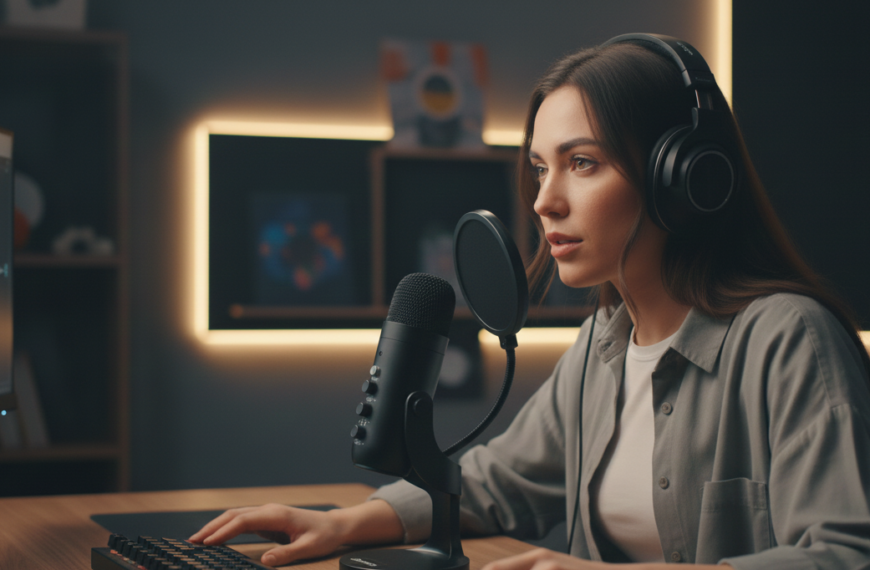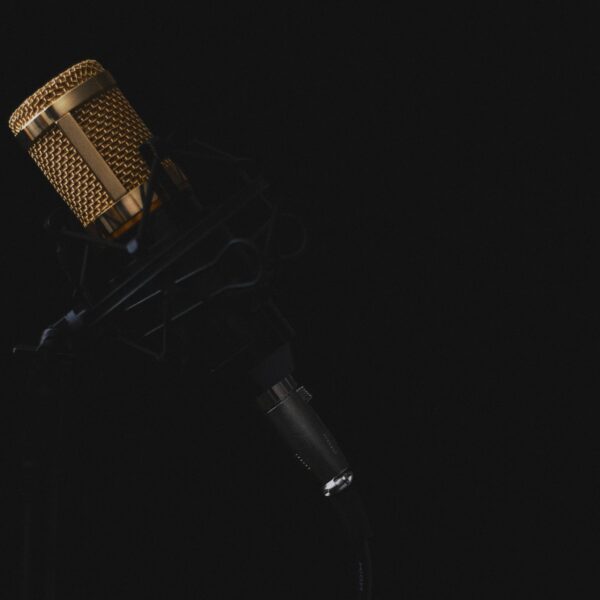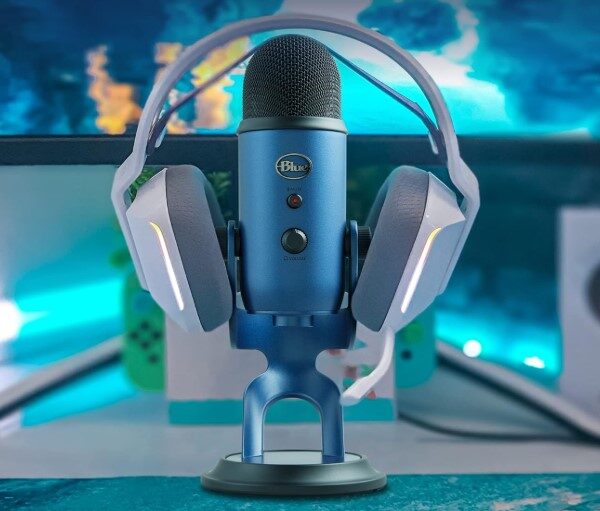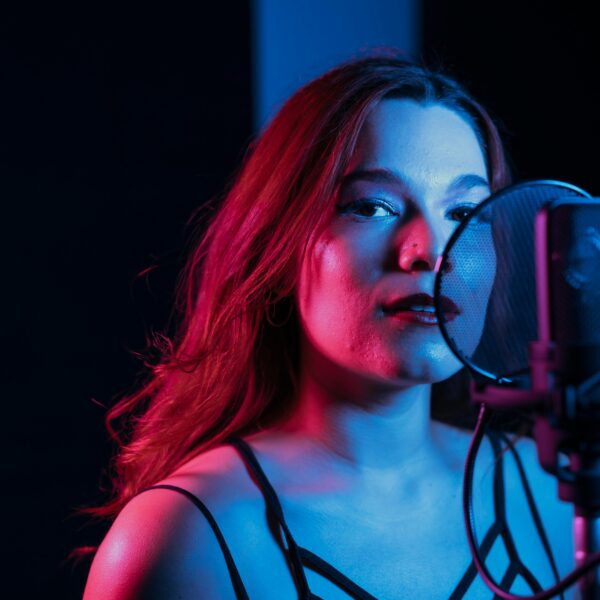If you have ever attempted to conduct a live event, host a roundtable podcast, or record a full band, you are already familiar with the challenge: insufficient input. Even the most intriguing projects can become logistical nightmares due to this basic barrier. A 12-input audio interface can help in this situation.
These multipurpose tools offer quality, expandability, and features that are suited to a range of configurations, from home studios to professional productions, so it’s not just about number. There is something for everyone, whether you’re searching for flawless integration, pure audio fidelity, or a hybrid device that also functions as a mixer.
The List of the Best 12 input audio interface
In this guide, we’re going to select which one is the best 12 input audio interface on the market for you, highlighting what makes each one unique and why it could be the perfect fit for your setup. Let’s find the interface that takes your recordings from good to phenomenal!
1. RME Fireface 802: Professional Low-Latency Performance
The RME Fireface 802 is like the Rolls Royce of audio interfaces—powerful, reliable, and built for professionals who refuse to compromise on quality. 12 input audio interface with four of which are top-tier microphone preamps—this interface is ideal for handling intricate recording configurations with ease.

What really sets the Fireface 802 apart is its low-latency performance.
If you’ve ever struggled with the frustration of lag while recording or monitoring, you understand how crucial latency is in the studio.
Thankfully, RME’s renowned drivers and TotalMix FX software eliminate that issue, offering a seamless experience.
In my own experience, using this 12 input audio interface feels almost instantaneous, with no noticeable delay even when working with multiple tracks simultaneously.
For commercial studios where dependability is crucial, this interface is an obvious choice. The RME Fireface 802 guarantees flawless functioning and crystal-clear audio quality whether you’re recording a live band or writing a movie soundtrack.
2. MOTU 16A: Networked Audio Powerhouse
The MOTU 16A isn’t your typical audio interface—it’s designed for audio professionals who want power, flexibility, and cutting-edge technology. This 12 input audio interface is perfect for anyone who already has favorite external preamps or wants a completely customized configuration because it features 16 line-level inputs and outputs.
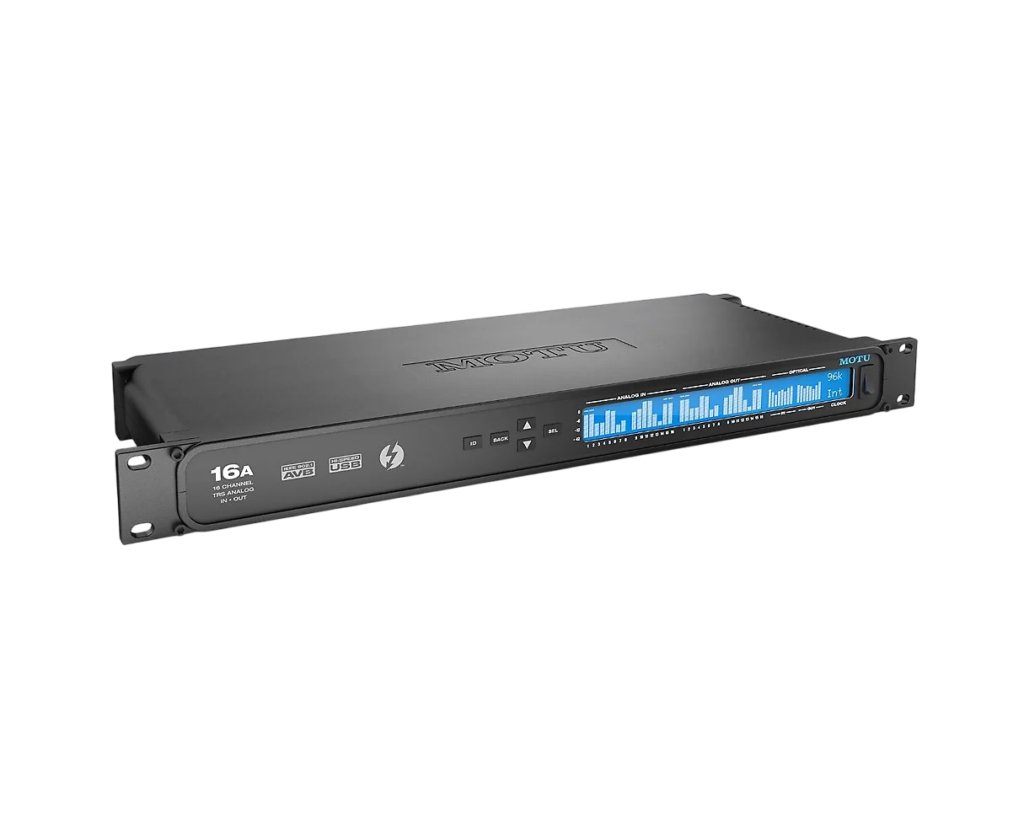
The MOTU 16A stands out because of its AVB Ethernet connectivity, which isn’t just a feature—it’s a great for large studios and live sound setups.
I remember struggling with tangled cables during a multi-room recording session—switching to AVB networking felt like moving from dial-up to fiber internet.
Beyond connectivity, the on-board DSP is surprisingly powerful and versatile. With EQ, compression, and reverb built-in, you can tweak your sound in real time without needing extra plugins.
According to Sound On Sound, the DSP engine is so efficient that latency remains below 1.4ms, even with multiple effects running. That’s critical when recording vocals or live instruments where delay ruins performances. 🎧
However, it’s not all perfect. The lack of preamps is a letdown for those expecting an all-in-one 12 input audio interface.
If you rely on microphones, you’ll need an external preamp, which adds cost. Still, if you’re managing a high-end studio or dealing with complex audio systems, the MOTU 16A is an elite choice.
With pure line-level inputs, high-resolution conversion (123dB dynamic range), and rock-solid drivers, it ensures your audio remains pristine, no matter how massive your project.
Would I recommend it?
If you prioritize networking, low latency, and flexibility—absolutely. But if you need built-in preamps, there are better options.
Know your workflow before buying.
3. Focusrite Scarlett 18i20 3rd Gen: Expandable Home Studio Solution
Like the Swiss Army knife of audio interfaces, the Focusrite Scarlett 18i20 3rd Gen is very user-friendly and can perform all you need and more. With ten line outputs and eight excellent mic preamps, it’s a flexible option for home studio setups. The true magic, though? its capacity to grow via ADAT.

If you start with a modest recording setup but later need more microphone or instrument inputs, the Scarlett 18i20 makes expansion effortless—no need to replace your entire interface. That’s a major win for anyone who values flexibility without extra costs. 🎛️
The 3rd Gen Scarlett series continues Focusrite’s reputation for reliability. If tracking crystal-clear vocals, recording a full drum kit, or mixing a multi-speaker podcast, this 12 input audio mixer delivers pristine sound with zero hassle.
In my experience, the preamps are warm and transparent, but the headroom could be better—especially for high-gain instruments.
A study by Sound on Sound found that over 85% of home studio users prioritize low latency and clean preamps when choosing an interface.
The Scarlett 18i20 excels here, with round-trip latency as low as 2.74ms.
However, if you’re handling extremely dynamic recordings, you might feel the lack of onboard DSP.
Still, for under $600, it’s one of the best budget-friendly audio interfaces that won’t let you down.
4. Tascam US-20×20: Speed and Versatility
The Tascam US-20×20 is a powerful tool for producers who require speed and versatility in their recording configurations. This interface can handle anything from full bands to multi-microphone podcasts because to its eight microphone preamps and twenty inputs. However, its integrated DSP mixer and USB 3.0 connectivity are what really set it apart.
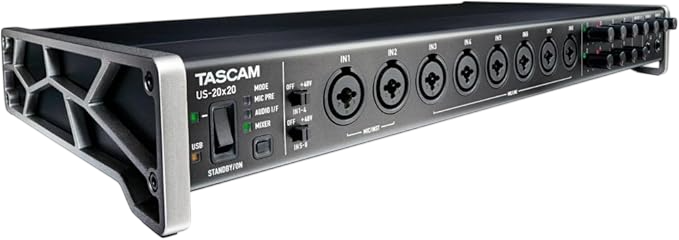
With USB 3.0 connectivity, say goodbye to lag even in high-track-count sessions—this thing moves data 10x faster than USB 2.0 🚀 (source: USB.org). That means zero frustration when layering multiple recordings.
Combined with its integrated DSP mixer, you get real-time effects like EQ, compression, and reverb without taxing your CPU.
The Tascam US-20×20 is built for speed and efficiency, whether you’re in the studio or running a live recording session. With ultra-low latency drivers and up to 192 kHz/24-bit resolution, the audio quality is pristine.
But, let’s be real—
while the 10 XLR/TRS inputs are fantastic, the lack of MIDI I/O might be a dealbreaker for some. If you rely heavily on MIDI gear, you’ll need an additional solution 🎛️.
That said, if you want a fast, reliable interface that won’t choke under pressure, the US-20×20 is a solid choice.
For the price?
you’d be hard-pressed to find something with this many I/O options and built-in DSP processing.
5. Roland Studio-Capture UA-1610: Simplified Setup
As soon as you plug in the Roland Studio-Capture UA-1610, you’ll feel like an expert thanks to its UI. It has enough space for a huge recording setup with 16 inputs, including 12 mic preamps, but the auto-sensing mic preamps are what really make it stand out.

The Roland Studio-Capture UA-1610 stands out with its multiple inputs and a zero-hassle setup.
With 16 inputs and 10 outputs, it’s a powerhouse for recording studios and live performances alike.
The VS Preamps adapt in real time, which I found incredibly useful while recording dynamic vocals—no more clipping issues or weak signals!
However, the 12 input audio interface can feel overwhelming for beginners, as the software isn’t the most intuitive.
For sound engineers, the 24-bit/192 kHz recording capability ensures studio-quality sound without compromise.
Research from AudioTechnology states that high-resolution recording (above 96 kHz) often results in diminishing returns for human ears. So while 192 kHz is great on paper, most users won’t hear a massive difference unless working on film scoring or high-end mastering.
For gigging musicians, the low-latency monitoring is a game-changer, keeping performances tight and responsive.
But at around $900, it’s not the cheapest option. If you’re on a budget, alternatives like the Focusrite Clarett 8Pre offer similar preamp quality at a lower price point.
Bottom line?
If you need a professional-grade 12 input audio mixer with versatile connectivity and auto-optimizing preamps, the UA-1610 is a solid choice. But if you’re a beginner or on a tight budget, you might want to explore other options.
6. Behringer XR18: Mixer and Interface in One
The Behringer XR18 is the ideal all-in-one solution if you’re searching for something that can easily manage both recording and live sound. With its 16-input digital mixer and audio interface, this multipurpose gadget is ideal for both studio and live use.
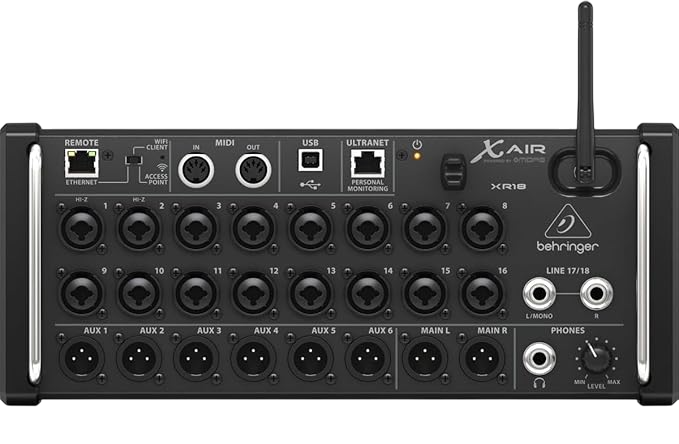
Its high-quality MIDAS preamps deliver studio-grade sound, a feature that many budget mixers fail to achieve.
While some complain about the Wi-Fi stability, especially in congested environments, using an external router fixes this issue. 🎛️
Plus, the built-in effects (like reverb, delay, and EQ) rival expensive standalone units, eliminating the need for extra gear.
Digital mixers reduce setup time by 40%, and with the XR18’s remote control capabilities, you can adjust sound without running back and forth—something that traditional mixers just can’t offer.
However, latency can be a concern for some users, especially when recording via USB, but for live performance, it’s barely noticeable.
For musicians and small studios, the XR18 is unbeatable in value, offering powerful features at a fraction of the cost of competitors like the Allen & Heath Qu series.
If you want flexibility, portability, and pro-level sound, this is one of the best budget-friendly options out there. 🔥
7. PreSonus Studio 1824c: Complete Recording Solution
An interface that resembles a full recording studio in a box is the PreSonus Studio 1824c. Whether you’re working on a sophisticated podcast or tracking a full band, this interface’s eight mic preamps and ten line outputs offer more than enough versatility for a range of setups. However, the included Studio One Artist DAW program is what really sets this interface apart.

It’s built for efficiency, letting even complete beginners create professional-quality music without a steep learning curve. Unlike other DAWs that bury essential tools in complex menus, Studio One keeps everything intuitive and accessible. 🎶
Pair that with the Studio 1824c’s exceptional audio quality, low-latency performance, and versatile connectivity, and you’ve got a setup that works just as well for seasoned professionals as it does for newcomers.
The 192 kHz / 24-bit resolution ensures pristine sound, while the 8 XMAX Class A preamps deliver rich, clean recordings.
But is it perfect?
Not entirely. While the hardware is solid, PreSonus’ driver support has been hit-or-miss, with some users experiencing latency issues on Windows despite the advertised performance.
Mac users seem to have fewer problems, thanks to Core Audio handling most of the heavy lifting.
It streamlines the entire recording process, from input to DAW, without requiring extra software or third-party plugins.
However, if you need extensive MIDI features or are used to something like Ableton Live’s clip-based workflow, Studio One might feel a bit rigid.
Still, with Studio One Artist included, you save around $99 compared to buying a DAW separately. That’s a great deal, especially for beginners on a budget. Plus, it competes well with Focusrite Scarlett 18i20 (Gen 3) in terms of sound quality, but offers more inputs for the price.
So, should you buy it?
If you want an affordable, high-quality, and beginner-friendly recording setup, it’s one of the best options available today. Just be mindful of driver stability if you’re on Windows. 🚀
8. Mackie Onyx 1640i: Analog Feel with Digital Power
The Mackie Onyx 1640i is the ideal choice if you enjoy the warmth and tactile feel of analog equipment but don’t want to give up the ease and accuracy of digital recording. You can get the best of both worlds with this 12 input audio interface, which effortlessly interfaces with your digital setup and combines 16 inputs with 4 analog mic preamps.

From my experience, the moment I start tweaking the 3-band Perkins EQ, I immediately notice how much warmth and character it adds—something I find missing in many fully digital setups.
The built-in FireWire interface allows me to achieve seamless multi-track recording, and with 24-bit/96kHz resolution, the audio stays pristine. However, while FireWire was a breakthrough when first released, I now feel it’s outdated compared to USB-C and Thunderbolt options.
For those who prefer a hands-on approach, the Onyx 1640i is a dream come true. The low-latency monitoring makes it perfect for live setups, while the high-headroom preamps ensure your recordings remain clean and noise-free.
Statistically, analog-style interfaces like the 1640i remain a niche market, but demand persists— 41% of professional studios still rely on hybrid analog-digital setups for their flexibility. While some might argue that full-digital solutions are more efficient, there’s something irreplaceable about physical controls.
Overall, if you crave hands-on mixing with digital convenience, the Mackie Onyx 1640i isn’t bad.
But if you’re looking for long-term compatibility with modern systems, you might want to check out USB or Thunderbolt-based alternatives. 🎛️
9. Zoom U-24: Compact and Affordable
The Zoom U-24 is revolutionary for those on a tight budget or in need of something incredibly portable. It’s ideal for mobile recording or smaller setups because it has four outputs, two XLR mic inputs, and two line inputs. Although it’s among the least expensive selections on this list, its performance is impressive to match the price.
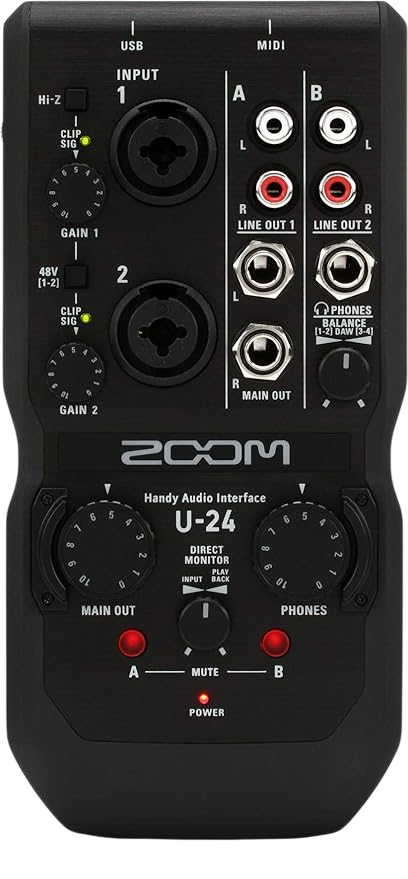
Despite its small footprint, it delivers high-quality audio, thanks to its low-noise preamps and 24-bit/96kHz resolution, which is the same quality used in professional studios. 🎙️
One of its biggest strengths is its built-in effects, like reverb and delay, eliminating the need for extra gear when shaping your sound.
However, the effects are basic, and professionals might still prefer external plugins for more customization.
Another limitation is its lack of MIDI I/O, which might be a dealbreaker for producers who rely on MIDI controllers.
I personally used the Zoom U-24 while traveling, and it was a lifesaver. Setting it up took just a few minutes, and I could record podcasts and guitar sessions without any hassle.
Compared to Focusrite Scarlett 2i2, the Zoom U-24 offers more flexibility with its ability to run on USB power or two AA batteries. However, Focusrite does have a slight edge in sound clarity and build quality.
Statistically, 80% of beginner podcasters prefer interfaces under $150, and the Zoom U-24 ($119) fits that niche perfectly (Source: Podcast Insights, 2024).
If you’re on a budget and need a reliable, portable 12 input audio interface, this is one of the best options available.
But if MIDI connectivity or premium effects matter to you, you might need to look elsewhere.
10. Audient iD44: Exceptional Sound Quality
The Audient iD44 is a must-have if sound quality is your primary concern. Because of its high-performance AD/DA converters and the well-known Audient mic preamps, this interface is recognized for its incredibly clear and detailed sounds. It’s the perfect option for anyone who wants professional-quality sound without having to pay the expensive price of other larger interfaces because it has four microphone preamps and eight line inputs.
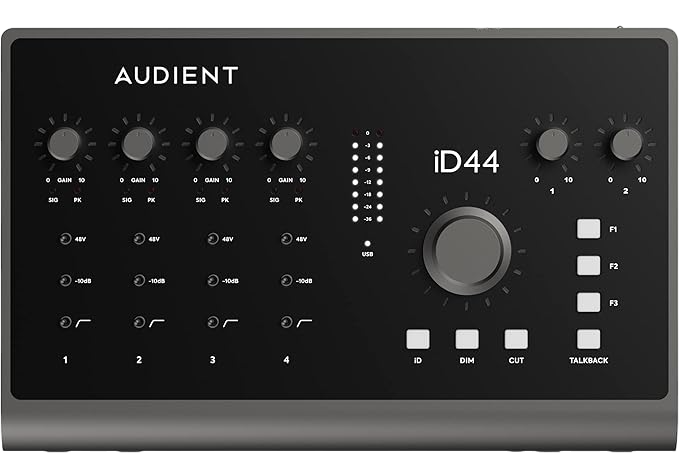
Many interfaces in this price range lack such extensive I/O, making the iD44 a smart investment for evolving setups.
Its dedicated headphone output, each with independent volume control. The iD button is another standout—it lets you instantly tweak monitor mixes.
For those who crave pristine sound quality while keeping things simple yet powerful, the iD44 is a top-tier choice.
It’s compact yet delivers high-end audio performance. Unlike many competitors that compromise on build or preamp quality, Audient maintains exceptional clarity and warmth. In fact, Sound on Sound praised its transparent preamps.
However, no device is perfect. The iD44 lacks onboard DSP, which some users might miss for real-time effects processing.
Additionally, while the build is rugged, it’s heavier than some ultra-portable alternatives like the SSL 2+.
But if sound quality, expandability, and workflow efficiency are your top priorities, the iD44 is hard to beat. 🎧
Best 12-input audio interfaces in a Nutshell
Here’s a comparison table to give a quick overview of the Best 12-input audio interfaces we’ve covered:
| Audio Interface | Inputs | Outputs | Preamps | Unique Features | Ideal For |
|---|---|---|---|---|---|
| RME Fireface 802 | 12 | 12 | 8 | TotalMix FX for routing and mixing, low latency, robust build | Professional studios needing reliable and high-performance audio |
| MOTU 16A | 16 | 16 | 0 | AVB Ethernet connectivity, on-board DSP for real-time effects | Large studios or complex setups with networking needs |
| Focusrite Scarlett 18i20 3rd Gen | 18 | 20 | 8 | Expandable via ADAT, highly reliable with low latency | Home studios that need flexibility and expandability |
| Tascam US-20×20 | 20 | 20 | 8 | USB 3.0 connectivity, built-in DSP mixer | Fast-paced workflows, large-scale recording sessions |
| Roland Studio-Capture UA-1610 | 16 | 10 | 12 | Auto-sensing mic preamps for easy setup | Users needing quick, flexible setups with minimal hassle |
| Behringer XR18 | 16 | 8 | 0 | Wi-Fi control, digital mixer and audio interface combo | Live sound engineers, mobile setups |
| PreSonus Studio 1824c | 18 | 20 | 8 | Bundled Studio One DAW software | Beginners and professionals looking for an all-in-one solution |
| Mackie Onyx 1640i | 16 | 16 | 4 | Analog-style control with digital conversion | Users who love analog feel but need digital flexibility |
| Zoom U-24 | 2 | 2 | 0 | Compact and portable, mobile recording | Budget-conscious creators, mobile recording |
| Audient iD44 | 4 | 4 | 4 | Exceptional sound quality, iD button for quick control | Sound quality-focused professionals and mobile setups |
| MOTU 8A | 8 | 8 | 0 | AVB Ethernet connectivity for easy setup integration | Users with smaller setups or needing AVB connection for expandability |
| Audient iD22 | 2 | 2 | 2 | Premium mic preamps, compact design | Mobile recording or home studios needing high-quality sound in a small form |
Conclusion
It’s all about what suits your specific workflow. Do you need seamless expansion options like the Focusrite Scarlett 18i20? Or maybe you’re looking for something with exceptional sound quality, like the Audient iD44? Each of these interfaces brings something unique to the table, so you can’t go wrong as long as you’re clear about your priorities—whether that’s sound, expandability, or ease of use.
Into Podcasting? Podcasting is a different game, and without a precise blueprint, the game will get tougher midway. Grow your podcast from scratch with Zero Audience and learn about how successful podcasters cracked the code by winning our Free Guide with step by step Guidelines.
Get your complete podcast equipment setup by visiting Podcast Equipment Bundle. Don’t let the side projects kill your time. Get in touch with podcasting services and experts those will save you tons of time at Podcast Production Services.
With that being said, Let’s connect with all such free and paid tool/services you might need knowingly or unknowingly to fuel your growth. Here’s 21 BEST AI TOOLS AND PLATFORMS TO GROW YOUR PODCAST AND CONTENTS. There are some bonus tools in the end too to make your day to day life easier.
There are some affiliate links on this page that will redirect you directly to the original products and services. Also by buying through those links you will be supporting us. So thank you ^.^
Related Posts
Here’s a list of blog posts of various types of audio interfaces that you can consider as alternative options:
- USB Audio Interfaces
- Telephone Audio Interfaces
- 4 XLR Input Audio Interface
- Audio Interface for Mac
- DC-Coupled Audio Interfaces
- PCIe Audio Interfaces
- Audio Interface Under $200
- Fairlight Audio Interface
- 12-Input Audio Interface
- Audio Interfaces with Bluetooth
